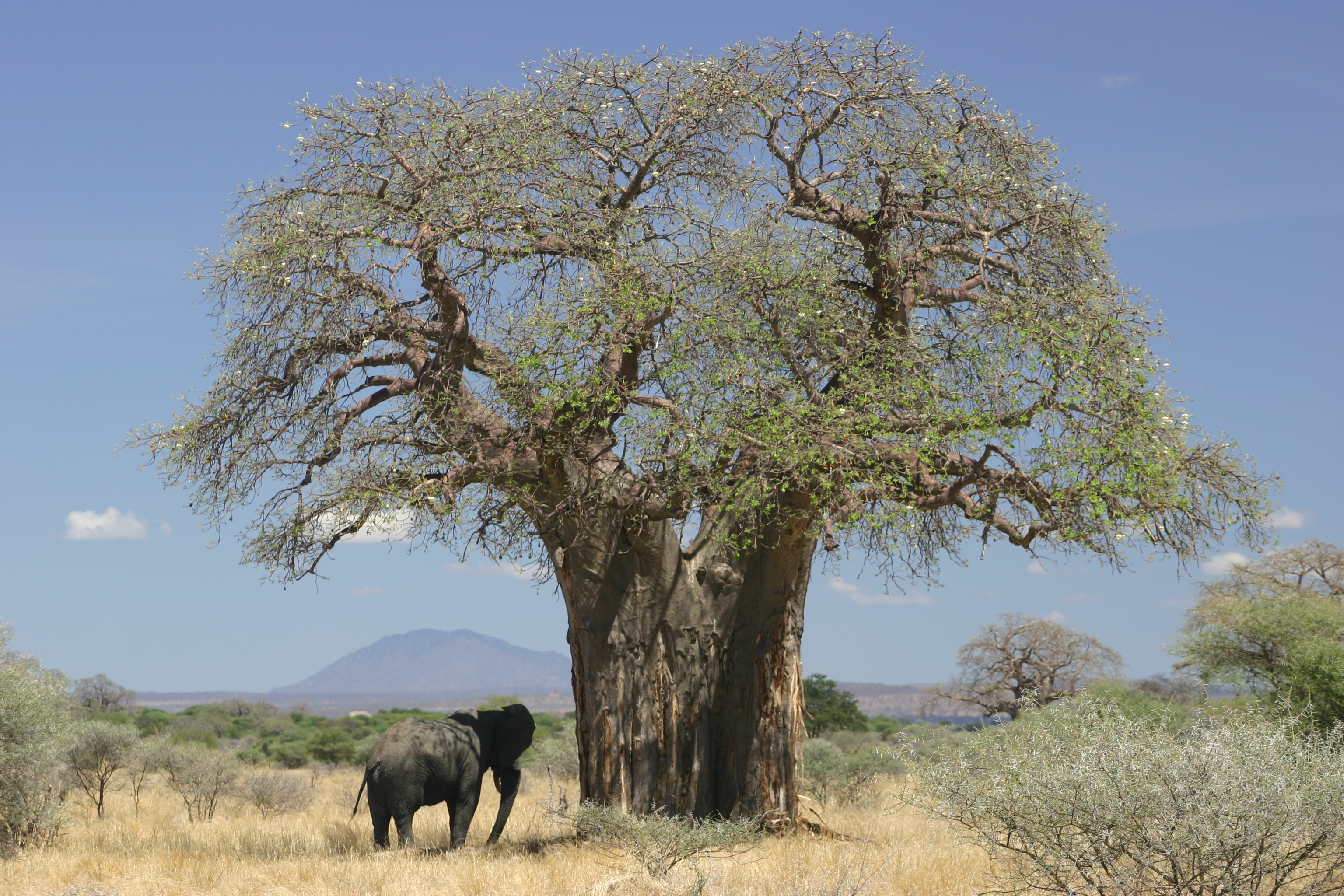- Adansonia digitata
taxobox
name = "Adansonia digitata"
image_caption = Baobab tree inTanzania
status = secure
regnum =Plantae
unranked_divisio =Angiosperms
unranked_classis =Eudicots
unranked_ordo =Rosids
ordo =Malvales
familia =Malvaceae
genus = "Adansonia"
species = "A. digitata"
binomial = "Adansonia digitata"
binomial_authority = L.|"Adansonia digitata", the baobab, is the most widespread of the "
Adansonia " species on the African continent, found in the hot, drysavanna hs ofsub-Saharan Africa . It also grows, having spread secondary to cultivation, in populated areas. The northern limit of its distribution in Africa is associated with rainfall patterns; only on the Atlantic coast and in theSudan does its occurrence venture naturally into theSahel . On the Atlantic coast this may be due to spreading after cultivation. Its occurrence is very limited inCentral Africa and it is found only in the very north ofSouthern Africa . InEastern Africa the trees grow also in shrublands and on the coast. InAngola andNamibia the baobabs grow in woodlands, and in coastal regions, in addition to savannahs. The trees usually grow as solitary individuals, and are large and distinctive trees on the savannah, in the scrub, and near settled areas, with some large individuals living to well over a thousand years of age.Fact|date=July 2008The tree bears very large, heavy white flowers. The showy flowers are pendulous with a very large number of stamens. They carry a
carrion scent and researchers have shown they appear to be primarily pollinated byfruit bat s of the subfamilyPteropodinae . The fruits are filled with pulp that dries, hardens, and falls to pieces which look like chunks of powdery, dry bread. [cite book |authorlink= |author=National Research Council |editor= |others= |title=Lost Crops of Africa: Volume III: Fruits |origdate= |url=http://books.nap.edu/openbook.php?record_id=11879 |format= |accessdate=2008-07-15 |edition= |series=Lost Crops of Africa |volume=3 |date=2008-01-25 |publisher=National Academies Press |location= |isbn=978-0-309-10596-5 |oclc= |doi= |id= |pages= |chapter=Baobab |chapterurl=http://books.nap.edu/openbook.php?record_id=11879&page=41 |quote= |ref= ]The specific epithet "digitata" refers to the fingers of a hand, which the five leaflets (typically) in each cluster bring to mind.
The baobab is a traditional food plant in Africa, but is little-known elsewhere. It has been suggested that the vegetable has the potential to improve nutrition, boost food security, foster rural development and support sustainable landcare. [cite book |authorlink= |author=National Research Council |editor= |others= |title=Lost Crops of Africa: Volume II: Vegetables |origdate= |url=http://books.nap.edu/openbook.php?record_id=11763 |format= |accessdate=2008-07-15 |edition= |series=Lost Crops of Africa |volume=2 |date=2006-10-27 |publisher=National Academies Press |location= |isbn=978-0-309-10333-6 |oclc= |doi= |id= |pages= |chapter=Baobab |chapterurl=http://books.nap.edu/openbook.php?record_id=11763&page=75 |quote= |ref= ]
Vernacular names
"Adansonia digitata" is known by many names, the most common of which is baobab. It is also known as the 'dead-rat tree' (from the appearance of the fruits), 'monkey-bread tree' (the soft, dry fruit is edible), 'upside-down tree' (the sparse branches resemble roots) and cream of tartar tree. In French, it is known as calebassier du Sénégal and arbre de mille ans; in Portuguese as molambeira, imbondeiro, calabaceira and cabacevre; and in Swahili as mbuyu, mkuu hapingwa, mkuu hafungwa and muuyu.Grubben, G.J.H. & Denton, O.A. (2004) Plant Resources of Tropical Africa 2. Vegetables. PROTA Foundation, Wageningen; Backhuys, Leiden; CTA, Wageningen.]
It is called "Momret" in the
Tigrigna language of Ethiopia, where it favors lowland areas with moist and well-drained soils, such as the valley of theTekeze River lowlands. [ [http://www.africa.upenn.edu/faminefood/category3/Cat3_Adansonia_digitata.htm "Wild Food Plants Attracting Additional Consumer Categories": Adansonia digitata] (Famine Food Guide website)] "A. digitata" is called "Kuka" by the Hausa speaking people of West Africa. In Nigeria it is a very popular tree in the savannahs up North and it leaves used to prepare local soup called "miyan kuka".Fruit
The African baobab's
exotic fruit (6 to 8 inches, or 15 cm to 20 cm long) has twice as muchcalcium as milk, is high inanti-oxidants , iron and potassium, and has 6 times thevitamin C of an orange. The leaves can be eaten asrelish , while the fruit dissolved in milk or water can be used as a drink. The seeds also produceedible oil .In 2008, the
EU approved the use and consumption of baobab fruit as an ingredient in cereal bars andsmoothies . A nonprofit organization, PhytoTrade Africa, plans to market the fruit for the benefit of around 2.5 million of the poorest families in southern Africa. [ [http://ukpress.google.com/article/ALeqM5g8aVYrwYmScGjqim-6adw-RZGbtg ukpress.google.com, Exotic fruit cleared for UK sale] ] [ [http://news.bbc.co.uk/2/hi/uk_news/7506997.stm news.bbc.co.uk, New exotic fruit to hit UK shops] ]References
External links
* [http://www.plantzafrica.com/plantab/adansondigit.htm Description and cultural information]
* [http://www.museums.org.za/bio/plants/malvaceae/adansonia_digitata.htm Structured description]
* [http://database.prota.org/dbtw-wpd/exec/dbtwpub.dll?AC=QBE_QUERY&TN=PROTAB~1&QF0=Species+Code&QI0=Adansonia+digitata&RF=Webdisplay PROTAbase on "Adansonia digitata"]Gallery
Wikimedia Foundation. 2010.
